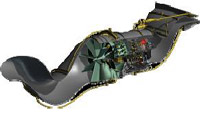Rolls-Royce's Liberty Works is set to start testing the core section of its US Air Force Research Laboratory-sponsored (AFRL) ADaptive Versatile ENgine Technology (ADVENT) engine development effort.
"All the hardware is ready to go, we in the process of instrumentation and assembly," says Mark Wilson, Rolls-Royce's North American chief operating officer. "We'll be testing it before the end of the year."
 |
|---|
| ©USAF |
The core is designed to be extremely high performance and highly efficient, Wilson says. But the key to Roll-Royce's ADVENT engine effort is variable cycle technology-which allows for efficient cruise performance and excellent high speed performance. The overall goal is to reduce fuel consumption by over 25%.
Rolls-Royce has already completed over 250 hours of rig testing on the engine's fan section. Thus, the next step will be to test the complete engine next year, Wilson says.
Rolls-Royce will continue to further refine the ADVENT design for the next phase of development, which falls under the USAF's adaptive engine technology development programme.
But in addition to the USAF's ADVENT effort, the company is working with the US Navy on another variable cycle engine project.
"We're also working with the navy on their programme called the variable cycle advanced technology or VCAT," Wilson says. "The navy is very interested in fuel efficient propulsion for carrier-based tac-air and ISR [intelligence, surveillance and reconnaissance] aircraft."
Wilson says the USN hopes to exploit variable cycle engine technology for its unique set of requirements. The USN is leveraging the USAF's ADVENT efforts as part of its programme, he adds.
Rolls-Royce is also working with Lockheed Martin and NASA to develop a variable cycle engine that could be used on supersonic transport aircraft. The company is working on a three stream nozzle as part of that effort, Wilson says. A 15% sub-scale version of the nozzle is already being tested. It is hoped the design will help reduce the noise footprint of a potential future supersonic transport.
In addition to the variable cycle engine efforts, Rolls Royce is working on the USAF's Highly Efficient Embedded Turbine Engine (HEETE) effort to develop a new class of engine for transports and surveillance aircraft.
The goal of the HEETE effort is to develop an engine that can cut fuel burn rates by over 35%, Wilson says. To accomplish that goal the engine will need very high pressure ratios and have a very high temperature core. Increasing the efficiency of the core is of particular importance on the HEETE because there is already a very high bypass ratio, Wilson says.
Meanwhile, development work is continuing. A compressor section for the new HEETE engine will be tested later this year, Wilson says. The test rig is currently being installed.
Source: Flight International























